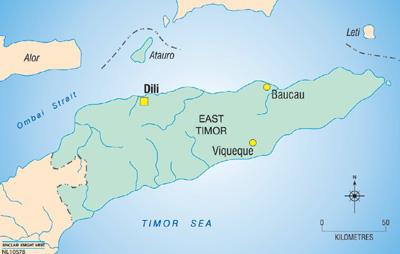Bridge of life and hope
This is the story of a crisis in a small town in East Timor and how a group of Australians working with the United Nations contributed to its resolution. Viqueque is the capital of the Viqueque region in the east of the country. Home to about 65,000 people, the region consists mainly of small villages relying on cashcropping and subsistence farming. It is rich in military history, from the occupation by the Portuguese in the 16th century to the armed resistance by Falintil guerrillas against the Indonesian occupation, to the restoration of law and order by the recent Australianled Interfet (International Force in East Timor) operation, to the current UN operations.
The region experienced its worst wet season in more than 20 years in May–July 2000 and it arrived in dramatic fashion. The night of 11 May began like any other calm and balmy tropical evening, but the birds were unusually quiet. Darkness fell quickly as dark clouds gathered and an electrical storm unleashed torrential rain. Within minutes, the river near the township of Viqueque was flooding and dozens of houses were awash with rushing water. The river rose by six metres within hours and the people hurriedly evacuated to higher ground.

The UN military observers and civilian police, including several Australians, coordinated the movement of local people. At times they waded into the dark and swirling river waters as the rain continued to pour down, calling for those who were still missing and presumed lost. Suddenly, a radio report from a Malaysian civilian police officer brought very bad news: “The bridge is not here! The bridge is gone!” The only bridge that connected the Viqueque region to the rest of East Timor had succumbed to the incredible water pressure. Just then a convoy of six UN vehicles arrived at the other side of the river from Baucau on the north, but fortunately the quick-thinking policeman flashed his headlights at them, preventing what might have been a disaster.
At dawn the following morning it was possible to assess the damage. Miraculously, no one had been killed but many houses were damaged and much livestock was gone forever. The timber bridge was destroyed and the river could only be crossed by wading or swimming. The so-called “broken bridge” became a major transport choke point with UN vehicles parked on either side and shuttle services being organised to maintain UN operations. Helicopters were also to play a major part in the lives of all UN personnel from then on and the military observers were to coordinate hundreds of sorties.
But the lives of the local Timorese were much more seriously affected by the destruction of the bridge. They were cut off from suppliers of goods and services, and from the markets for their agricultural produce. To make matters worse, these people had little access to UN vehicles or helicopters. Something had to be done, and quickly, so that the UN could retain the confidence of the local people.
Viqueque had not been alone in losing its bridge and its geographic isolation meant that it risked being overlooked in the national repair process. Several Australian civilians worked hard to lobby for the urgent repair of the Viqueque bridge, including the District Administrator and the Infrastructure Officer, both senior members of the UN bureaucracy. Fortunately, the bridge was the main supply route for the Thai airborne infantry that guarded Viqueque and this provided an added reason to restore the bridge as soon as possible.
The Deputy Force Commander of the UN Peacekeeping Force, Major General Mike Smith, another Australian, took a personal interest in the situation. Within a short time he had deployed troops from the Bangladeshi Engineer Battalion by road from Dili to build a 30-metre Bailey Bridge. The final Australian element was a team of four Australian Air Despatch soldiers, who arrived by helicopter and coordinated the movement of the bridge sections. This required 40 sorties by giant Russian MI-8 helicopters from Baucau and took three days.
The engineers quickly assembled the bridge and it was then physically “launched” across the river by a mass of international manpower. Hundreds of people pushed together, including Bangladeshi, Thai and Australian Peace Keeping Force troops, local civilians, Australian UN civilians, civilian police and military observers.
On 6 June, four weeks after the loss of the broken bridge, Major General Smith and local community leaders opened the Bailey Bridge and restored Viqueque’s lifeline to the outside world. The leaders of the Viqueque community graciously thanked the military and civilian personnel of many nations for replacing the bridge. Many Australians, and particularly Australian service-personnel, had played their part in nation-building and helped secure the lives of the people of Viqueque.
“H” detachment Sparrow Force at Viqueque, 1942
Text © the Author